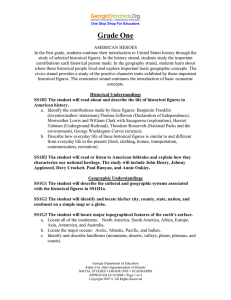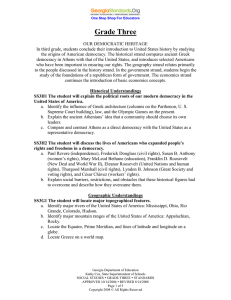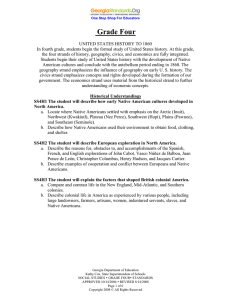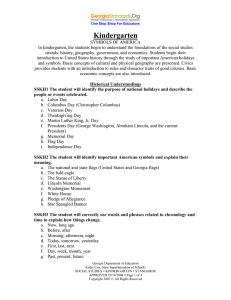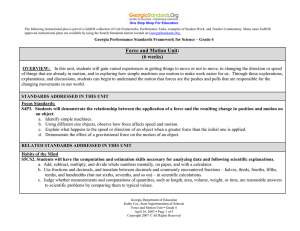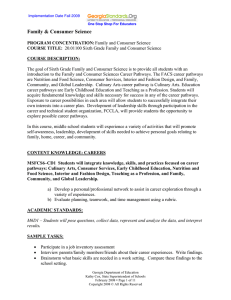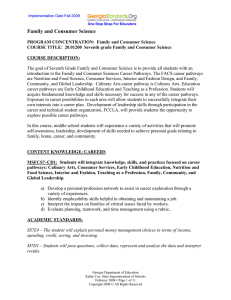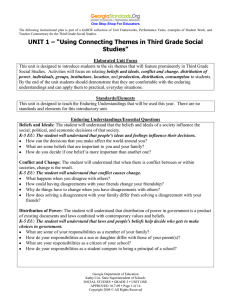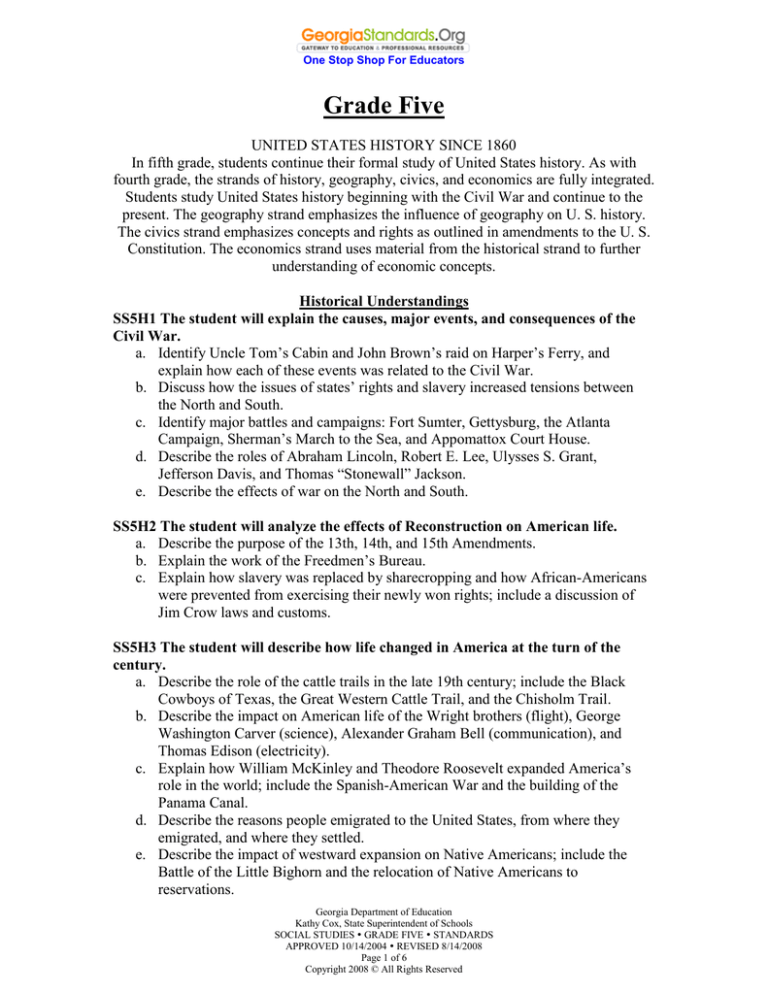
One Stop Shop For Educators
Grade Five
UNITED STATES HISTORY SINCE 1860
In fifth grade, students continue their formal study of United States history. As with
fourth grade, the strands of history, geography, civics, and economics are fully integrated.
Students study United States history beginning with the Civil War and continue to the
present. The geography strand emphasizes the influence of geography on U. S. history.
The civics strand emphasizes concepts and rights as outlined in amendments to the U. S.
Constitution. The economics strand uses material from the historical strand to further
understanding of economic concepts.
Historical Understandings
SS5H1 The student will explain the causes, major events, and consequences of the
Civil War.
a. Identify Uncle Tom’s Cabin and John Brown’s raid on Harper’s Ferry, and
explain how each of these events was related to the Civil War.
b. Discuss how the issues of states’ rights and slavery increased tensions between
the North and South.
c. Identify major battles and campaigns: Fort Sumter, Gettysburg, the Atlanta
Campaign, Sherman’s March to the Sea, and Appomattox Court House.
d. Describe the roles of Abraham Lincoln, Robert E. Lee, Ulysses S. Grant,
Jefferson Davis, and Thomas “Stonewall” Jackson.
e. Describe the effects of war on the North and South.
SS5H2 The student will analyze the effects of Reconstruction on American life.
a. Describe the purpose of the 13th, 14th, and 15th Amendments.
b. Explain the work of the Freedmen’s Bureau.
c. Explain how slavery was replaced by sharecropping and how African-Americans
were prevented from exercising their newly won rights; include a discussion of
Jim Crow laws and customs.
SS5H3 The student will describe how life changed in America at the turn of the
century.
a. Describe the role of the cattle trails in the late 19th century; include the Black
Cowboys of Texas, the Great Western Cattle Trail, and the Chisholm Trail.
b. Describe the impact on American life of the Wright brothers (flight), George
Washington Carver (science), Alexander Graham Bell (communication), and
Thomas Edison (electricity).
c. Explain how William McKinley and Theodore Roosevelt expanded America’s
role in the world; include the Spanish-American War and the building of the
Panama Canal.
d. Describe the reasons people emigrated to the United States, from where they
emigrated, and where they settled.
e. Describe the impact of westward expansion on Native Americans; include the
Battle of the Little Bighorn and the relocation of Native Americans to
reservations.
Georgia Department of Education
Kathy Cox, State Superintendent of Schools
SOCIAL STUDIES GRADE FIVE STANDARDS
APPROVED 10/14/2004 REVISED 8/14/2008
Page 1 of 6
Copyright 2008 © All Rights Reserved
One Stop Shop For Educators
SS5H4 The student will describe U.S. involvement in World War I and post-World
War I America.
a. Explain how German attacks on U.S. shipping during the war in Europe (19141917) ultimately led the U.S. to join the fight against Germany; include the
sinking of the Lusitania and concerns over safety of U.S. ships, U.S. contributions
to the war, and the impact of the Treaty of Versailles in 1919.
b. Describe the cultural developments and individual contributions in the 1920s of
the Jazz Age (Louis Armstrong), the Harlem Renaissance (Langston Hughes),
baseball (Babe Ruth), the automobile (Henry Ford), and the airplane (Charles
Lindbergh).
SS5H5 The student will explain how the Great Depression and New Deal affected
the lives of millions of Americans.
a. Discuss the Stock Market Crash of 1929, Herbert Hoover, Franklin Roosevelt, the
Dust Bowl, and soup kitchens.
b. Analyze the main features of the New Deal; include the significance of the
Civilian Conservation Corps, the Works Progress Administration, and the
Tennessee Valley Authority.
c. Discuss important cultural elements of the 1930s; include Duke Ellington,
Margaret Mitchell, and Jesse Owens.
SS5H6 The student will explain the reasons for America’s involvement in World
War II.
a. Describe Germany’s aggression in Europe and Japan’s aggression in Asia.
b. Describe major events in the war in both Europe and the Pacific; include Pearl
Harbor, Iwo Jima, D-Day, VE and VJ Days, and the Holocaust.
c. Discuss President Truman’s decision to drop the atomic bombs on Hiroshima and
Nagasaki.
d. Identify Roosevelt, Stalin, Churchill, Hirohito, Truman, Mussolini, and Hitler.
e. Describe the effects of rationing and the changing role of women and AfricanAmericans; include “Rosie the Riveter” and the Tuskegee Airmen.
f. Explain the U.S. role in the formation of the United Nations.
SS5H7 The student will discuss the origins and consequences of the Cold War.
a. Explain the origin and meaning of the term “Iron Curtain.”
b. Explain how the United States sought to stop the spread of communism through
the Berlin airlift, the Korean War, and the North Atlantic Treaty Organization.
c. Identify Joseph McCarthy and Nikita Khrushchev.
Georgia Department of Education
Kathy Cox, State Superintendent of Schools
SOCIAL STUDIES GRADE FIVE STANDARDS
APPROVED 10/14/2004 REVISED 8/14/2008
Page 2 of 6
Copyright 2008 © All Rights Reserved
One Stop Shop For Educators
SS5H8 The student will describe the importance of key people, events, and
developments between 1950-1975.
a. Discuss the importance of the Cuban Missile Crisis and the Vietnam War.
b. Explain the key events and people of the Civil Rights movement; include Brown
v. Board of Education (1954), the Montgomery Bus Boycott, the March on
Washington, Civil Rights Act, Voting Rights Act, and civil rights activities of
Thurgood Marshall, Rosa Parks, and Martin Luther King, Jr.
c. Describe the impact on American society of the assassinations of President John
F. Kennedy, Robert F. Kennedy, and Martin Luther King, Jr.
d. Discuss the significance of the technologies of television and space exploration.
SS5H9 The student will trace important developments in America since 1975.
a. Describe U. S. involvement in world events; include efforts to bring peace to the
Middle East, the collapse of the Soviet Union, the Persian Gulf War, and the War
on Terrorism in response to September 11, 2001.
b. Explain the impact the development of the personal computer and the Internet has
had on American life.
Geographic Understandings
SS5G1 The student will locate important places in the United States.
a. Locate important physical features; include the Grand Canyon, Salton Sea, Great
Salt Lake, and Mojave Desert.
b. Locate important man-made places; include the Chisholm Trail; Pittsburgh, PA;
Gettysburg, PA; Kitty Hawk, NC; Pearl Harbor, HI; and Montgomery, AL.
SS5G2 The student will explain the reasons for the spatial patterns of economic
activities.
a. Explain how factors such as population, transportation, and resources influenced
industrial location in the United States between the end of the Civil War and
1900.
b. Locate primary agricultural and industrial locations since the turn of the 20th
century and explain how factors such as population, transportation, and resources
have influenced these areas.
Government/Civic Understandings
SS5CG1 The student will explain how a citizen’s rights are protected under the
U.S. Constitution.
a. Explain the responsibilities of a citizen.
b. Explain the freedoms granted and rights protected by the Bill of Rights.
c. Explain the concept of due process of law and describe how the U.S. Constitution
protects a citizen’s rights by due process.
SS5CG2 The student will explain the process by which amendments to the U.S.
Constitution are made.
a. Explain the amendment process outlined in the Constitution.
b. Describe the purpose for the amendment process.
Georgia Department of Education
Kathy Cox, State Superintendent of Schools
SOCIAL STUDIES GRADE FIVE STANDARDS
APPROVED 10/14/2004 REVISED 8/14/2008
Page 3 of 6
Copyright 2008 © All Rights Reserved
One Stop Shop For Educators
SS5CG3 The student will explain how amendments to the U. S. Constitution have
maintained a representative democracy.
a. Explain the purpose of the 12th and 17th amendments.
b. Explain how voting rights were protected by the 15th, 19th, 23rd, 24th , and 26th
amendments.
Economic Understandings
SS5E1 The student will use the basic economic concepts of trade, opportunity cost,
specialization, voluntary exchange, productivity, and price incentives to illustrate
historical events.
a. Describe opportunity costs and their relationship to decision-making across time
(such as decisions to ration goods during WWII).
b. Explain how price incentives affect people’s behavior and choices (such as
decisions to participate in cattle trails because of increased beef prices).
c. Describe how specialization improves standards of living, (such as how specific
economies in the north and south developed at the beginning of the 20th century).
d. Explain how voluntary exchange helps both buyers and sellers (such as how
specialization leads to the need to exchange to get wants and needs).
e. Describe how trade promotes economic activity (such as how the Panama Canal
increases trade between countries).
f. Give examples of technological advancements and their impact on business
productivity during the continuing development of the United States (such as the
development of the personal computer and the internet).
SS5E2 The student will describe the functions of four major sectors in the U. S.
economy.
a. Describe the household function in providing resources and consuming goods and
services.
b. Describe the private business function in producing goods and services.
c. Describe the bank function in providing checking accounts, savings accounts, and
loans.
d. Describe the government function in taxation and providing certain goods and
services.
SS5E3 The student will describe how consumers and businesses interact in the U. S.
economy.
a. Describe how competition, markets, and prices influence people’s behavior.
b. Describe how people earn income by selling their labor to businesses.
c. Describe how entrepreneurs take risks to develop new goods and services to start
a business.
SS5E4 The student will identify the elements of a personal budget and explain why
personal spending and saving decisions are important.
Georgia Department of Education
Kathy Cox, State Superintendent of Schools
SOCIAL STUDIES GRADE FIVE STANDARDS
APPROVED 10/14/2004 REVISED 8/14/2008
Page 4 of 6
Copyright 2008 © All Rights Reserved
One Stop Shop For Educators
Social Studies Skills Matrices
MAP AND GLOBE SKILLS
GOAL: The student will use maps to retrieve social studies information.
I: indicates when a skill is introduced in the standards and elements as part of the content
D: indicates grade levels where the teacher must develop that skill using the appropriate content
M: indicates grade level by which student should achieve mastery, the ability to use the skill in all
situations
A: indicates grade levels where students will continue to apply and improve mastered skills
Map and Globe Skills
K 1
1. use cardinal directions
I
2. use intermediate directions
3
4
5
6
M A
A
A
A
A A
A A
M A
A
A
A A
A A
I
M A
A
A A
A A
I
M A
A
A A
A A
I
M A
A
A A
A A
I
D
M A
A A
A A
I
D
M A
A A
A A
I
M A
A A
A A
I
D
D
D M A A
I
M A A
A A
I
M A A
A A
I
M A A
A A
I
3. use a letter/number grid system to
determine location
4. compare and contrast the categories of
natural, cultural, and political features
found on maps
5. use inch to inch map scale to determine
distance on map
6. use map key/legend to acquire
information from, historical, physical,
political, resource, product and economic
maps
7. use a map to explain impact of
geography on historical and current events
8. draw conclusions and make
generalizations based on information from
maps
9. use latitude and longitude to determine
location
10. use graphic scales to determine
distances on a map
11. compare maps of the same place at
different points in time and from different
perspectives to determine changes,
identify trends, and generalize about
human activities
12. compare maps with data sets (charts,
tables, graphs) and /or readings to draw
conclusions and make generalizations
Georgia Department of Education
Kathy Cox, State Superintendent of Schools
SOCIAL STUDIES GRADE FIVE STANDARDS
APPROVED 10/14/2004 REVISED 8/14/2008
Page 5 of 6
Copyright 2008 © All Rights Reserved
7
8
912
2
One Stop Shop For Educators
INFORMATION PROCESSING SKILLS
GOAL: The student will be able to locate, analyze, and synthesize information related to
social studies topics and apply this information to solve problems/make decisions.
I: indicates when a skill is introduced in the standards and elements as part of the content
D: indicates grade levels where the teacher must develop that skill using the appropriate content
M: indicates grade level by which student should achieve mastery, the ability to use
the skill in all situations
A: indicates grade levels where students will continue to apply and improve mastered skills
Georgia Department of Education
Kathy Cox, State Superintendent of Schools
SOCIAL STUDIES GRADE FIVE STANDARDS
APPROVED 10/14/2004 REVISED 8/14/2008
Page 6 of 6
Copyright 2008 © All Rights Reserved

